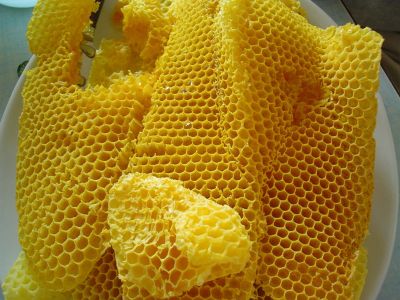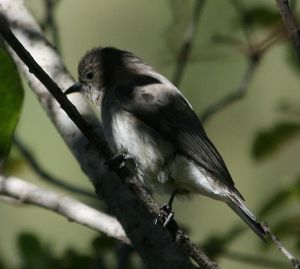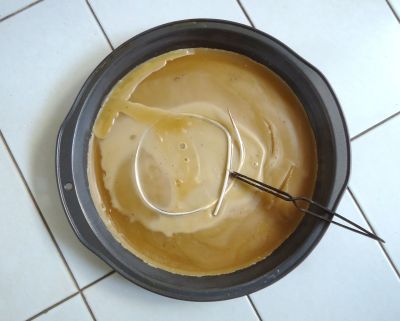What is beeswax?
Wax. Honey bees make it to build combs where they store food, place their eggs, grow their young.
The female honey bees have 8 wax-producing mirror glands, found on the inner part of their body. Their size depend on the age of the bees. After many days of flights, those glands begin to atrophy.
Initially the wax is transparent, and becomes opaque after mastication. It is nearly white when the combs are made, but become yellow and then brown when pollen and propolis are placed inside the wax cells.
Conditions to make the wax:
– the temperature in the hive must be 33 to 36°C (91 to 97°F) so the bees can secrete wax.
– bees must consume about eight times as much honey by mass. Beekeepers say that 6.66 to 8.80 pounds of honey yield 1 pound of wax. Measured in the distance, this will mean 150,000 miles for 1 pound of beeswax. Or, 530.000 km for 1 kg beeswax. A very good reason for its high price.
Can we eat beeswax?
No. I mean we can, but it’s not digestible. It will come out the same form. Experts say it is poorly hydrolyzed in the guts of humans and mammals, and so it is not significant as food. There are only some birds, called honeyguides (see picture), that can digest beeswax. The birds are called honeyguides, because they do exactly that, guide the beekeepers to bees’ swarms, because after the beekeepers take the colony, the birds can feed themselves with grubs and beeswax that are left behind.
Though we don’t eat it like that, we use beeswax in food preparation.
• As a coating for cheese, to protect it against spoilage.
• As a food additive, namely E901, a glazing agent which prevents water loss. Or it is given on some fruits to protect them. E901 can also be found in soft gelatin capsules or tablet coating.
• As a common ingredient of natural chewing gum.
What is beeswax good for?
First of all it is perfect for depositing honey in the hives. From here, people used it many different places, from packaging to processing and preservation. This type of wax is used today in:
- candles (they burn slowly and have a therapeutic effect);

- art: to make figures and statues or sculptures;
- modelling, jewelry – due to its plasticity and mouldability;
- glass and metal engraving, offering protection against etching acid;
- processing food, in bakery, for coating jellied sweets and liquors, used as separation agent, preservation or anti-sticking agent;
- pharmaceuticals: in drugs, pills, capsules, salve and ointments;
- physiotherapy: compresses – due to its warmth retaining capacity;
- ear plugs – because its soft and impermeable;
- cosmetics: in creams, lotions, lipstick, mascara, eye shadows, deodorants, depilatories, hairs conditioners;
- textiles, because it’s waterproof and paint resistant.
- musical instruments: flutes, didgeridoo, violins, drums;
- varnishing and polishing in paintings, art restoration, treatment of metal, wood, leather;
- industrial products: as an anti-corrosion rust inhibitor, or as lubricants.
See also: Honey cappings make the best healthy chewing gum! Ever!
Types of beeswax
Generally, beeswax can be classified into European and Oriental types. They have a lower saponification value (3–5) for European beeswax, and higher (8–9) for Oriental types.
According to its color, beeswax can be:
• yellow: it’s the crude product obtained from the honeycomb;
• white: it is yellow beeswax that has been bleached;
• beeswax absolute: it is yellow beeswax treated with alcohol.
Beeswax is not pure, that’s why its color is so different. Before it is used it can be clarified by heating it in water and it can also be softened with vegetable oils, to make it more workable at room temperature. It is easy to work with, because:
at 60.5° to 63°(C) it solidifies;
at 62 to 66°C (144 to 147°F) it melts;
at above 85°C (185°F ) its coloration disappears;
at 204.4°C (400°F) the flash point occurs. (the temperature at which a particular organic compound gives off sufficient vapor to ignite in air – source wikipedia.)
Where can we find beeswax?
Not all beekeepers gather the wax or process it to turn it into candles or other art objects. But many of them are. So if you are interested in buying some, ask the locals first.

And if you live in the middle of the city, like I am, there are online shops that sell beautiful candles turned into real works of art.

A bit of history:
Old Egyptians used it to embalm and mummify their pharaohs, to retain the permanency of wig curls, to preserve papyrus scrolls, to protect paintings; ancient Persans used wax to embalm their dead and ancient Romans modeled death masks and life-size effigies from beeswax.
The word mummy derives from a Persian word meaning wax.
Beeswax was also used as adhesive to join two surfaces together.
Icarus! Everyone knows about Icarus. He made himself a pair of wings, from bird feathers that were glued with beeswax. He wanted to escape from Crete, by flying over the sea. But he flew too high, and the wax melt. Thus he felt into the Aegean Sea and drown. His father flew at a lower height, arrived to Athens and there he built a temple to honor Apollo.
In the most famous medicine book of China, “The Shen Nong Book of Herbs”, beeswax was regarded as a top medicinal ingredient. Is says it is good for blood and energy system and the overall balance of the body. Combined with other ingredients it was used to treat wounds and as health food for dieting.
In religion, candles were made of beeswax. In the Roman Catholic Church, there was a rule stating that candles should be made of 100% beeswax. This law is still valid today, only that the percentage has been lowered to 5 – 50 %.
All the figurines and sculptures were made of beeswax and all the documents were sealed with beeswax.
Beeswax was considered a good business, but in the 19th century, paraffin was discovered and beeswax was no longer exclusive on the market.


Here is a useful book on how to turn wax from the hive into candles, soaps, bowls or whatever you want to create. The book is available on Amazon.com:
Beeswax Alchemy: How to Make Your Own Soap, Candles, Balms, Creams, and Salves from the Hive
Pictures’ sources:
honeycombs by via commons wikimedia
honeyguide bird by Alan Manson wikimedia commons;
Bee-master in Ukraina, picture by alxpn via flickr.com;
Handmade Beeswax bowls, picture by Simple Mama via flickr.com;
Beeswax, used to lubricate a silver wire, picture by Mauro Cateb, Brazilian jeweler and silversmith, via Commons Wikimedia
info references:
wikipedia

